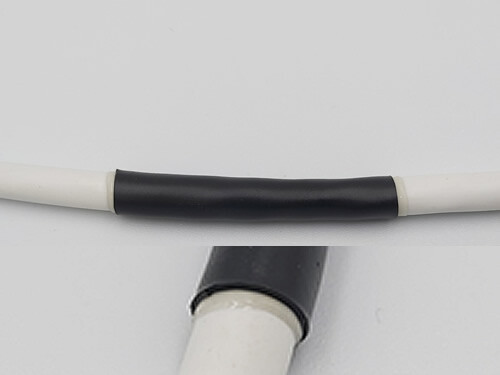Insulating electrical conductors in discrete circuits has been a necessary process since the inception of electricity. Many studies, developments and innovations in the wire industry have been made regarding thickness, physical characteristics, insulation material types — all with one goal. Safely and effectively insulating the electrical conductors carrying power.
Using Heatshrink
There are many implications for heatshrink tubing from safety and physcial reinforcement to identifying wire ends.
Safety
When a wire is stripped to reveal its inside conductors for crimping, soldering or connecting to an electrical system, there is often a need to re-cover the copper to protect the circuit from shorts and physical degradation.
Simple technologies such as electrical tape can effectively insulate a conductor, but in commercial grade machinery and devices, a more robust insulating material is needed that can be quantified to withstand forces from gases, liquids, high temperatures, high voltage, cold temperatures, flexibility etc.
There was also a need for different thicknesses of insulating material depending on application/voltage much like hookup wire styles available today.
Innovations in heatshrink technologies have driven improvements in material composition, physical characteristics and cost.
Reinforcement
Sometimes, heatshrink tubing is used to perform a clamping/strain-relief for wire that separate out of a wire harness breakout.
Usually when heatshrink is used for this application, a special type of tubing is applied with a glue coating on the inside diameter of the tubing. Once heated, the glue fills in the cracks between wires inside the tubing to create a solid joint to strain relieve the wires.
Identification
Another popular use for heatshrink tubing is wire end marking. There’s a great article available that gives a ton of insight into wire labelling technologies here.
Heatshrink Types
Below we will look at the types, ratios and learn some detailed aspects of a seemingly simple product.
Composition
1. Polyolefin
Polyolefin heatshrink is the most common style of heatshrink available today. You will likely know the classic matte black look of it. It has great insulating and abrasion properties and its a simple solution. It does not always provide adequate flexibility, moisture protection and can be easily stretched back out to reveal conductors.
2. PVC (Poly Vinyl Chloride)
This heatshrink material is similar to polyolefin, but provides enhanced characteristics. PVC tubing provides more chemical resistance than polyolefin and also protects from UV so it will not discolor. There is often an additional VW-1 flame rating for this type. Physically, PVC tubing has a smoother surface than polyolefin making it aesthetically more appealing.
3. PTFE (Teflon)
This is a special application tubing type made for harsh environments. Sometimes enhanced chemical, heat, corrosion and moisture characteristics are required of tubing. Teflon tubing provides just that with its ability to withstand more heat, flexibility and is extremely compatible with many other substances.
It is often used to encapsulate electronic conductors and in-line circuits that require protection where movement along its surface is possible. PTFE is nearly frictionless along other wire surfaces.
4. FEP (Fluorinated Ethylene Propylene)
This type of heatshrink tubing offers even more protection than PTFE chemically and is also used to encapsulate.
One typical application we see often with FEP tubing is to cover another printed heatshrink label to provide fluid and chemical resistance to the inks used for labelling.
5. Elastometric & Silicone
These type of heatshrink tubing are known for their enhanced flexibility at extremely high and low temperatures in addition to their chemical properties much like a combination of other tubings.
Glued vs Non-Glued

Most heatshrink comes in 2 styles depending on application. Single-walled tubing is the typical heatshrink used for general purpose for covering wire. Glued heatshrink is also known as double-walled heatshrink because it has 2 layers. We touched on it above in the “reinforcement” section but to recap, when heated, the glue oozes into cracks between wires or other electrical components being covered to create a moisture and gas tight seal around the contents. The downside to this protection is, the section covered by glued heatshrink has very little flexibility due to being solidified into place during cooling. Although it makes the best covering, it is not always the most practical.
Selecting the Correct Size Of Heatshrink Tubing
Heatshrink tubing needs to start at a larger diameter size than what is is covering, and shrink down to provide a tight seal against the surface being protected/covered.
Different shrink ratios have been designed for each heatshrink insulation type based on material characteristics and come in the following:
2:1 3:1 4:1 5:1 Custom Size
Usage
Heatshrink tubing should be the first choice for all wire coverings above any other solutions like electrical tape, or other means.
Heatshrink used for commercial products is certified and governed by CSA & UL much like wire and thus performs at a specific standard. Always make sure to spec the correct style for your applications.
Where to Get it
We stock many types, sizes, ratios and colors of heatshrink tubing at C-T Wire Prep Inc. for use on different custom applications. Call us today or visit our Online Store for more info and to place a purchase order!

